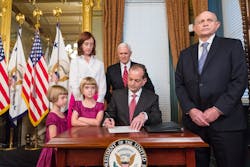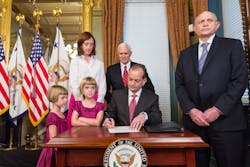Alexander Acosta, Department of Labor secretary, made clear last week the debate over overtime pay did not end when the new presidential administration took over in January.
Overshadowed by President Trump’s infrastructure speeches and James Comey’s testimony was Acosta telling a House subcommittee the overtime threshold for salaried employees needs adjusting.
That change will affect some dispatchers and other back-office personnel at trucking companies, though drivers and technicians are generally exempt from the rule.
At issue is a proposal from the Obama administration that would have raised the threshold for overtime-exempt employees to $47,476 annually for full-time employees from $23,660. In November, a judge issued an injunction, prevention the rule from going into effect as scheduled Dec. 1. The Trump administration faces a June 30 deadline to file a brief with the court.
Acosta said at the hearing the Department of Labor will request public comments on the overtime issue. A formal notice will be issued in the coming weeks.
He stood by comments made during his confirmation hearing that an increase is needed since it has remained unchanged since 2004.
“It’s unfortunate that rules that involve dollar values can sometimes go more than a decade, sometimes 15 years, without being updated. Because life does get more expensive,” Acosta said during his March confirmation hearing.
However, he also believes the Obama administration proposal went too far, and questioned if the Labor Department can legally raise the threshold level by more than the rate of inflation.
When the injunction was issued, most business groups were pleased, saying the rule would have forced managers to closely monitor the work of some salaried employees, stripping of them of flexibility needed to successfully run businesses.
But Acosta seems to be trying to find a middle ground, something so rarely sought in our current era of hyper-partisanship. He previously suggested a threshold around the $33,000 level, a figure likely to make both business and labor groups unhappy.
Beyond a specific figure, the agency will also need to decide if the figure should automatically increase every three years, as laid out in the blocked rule.
With so much attention in the 2016 presidential campaign on middle class jobs and wages, almost any Labor Department action could become a flash point in the 2018 and 2020 election cycles.
That makes it even more likely Acosta’s middle ground will take hold. A lower figure than what Obama proposed will cut into how many salaried employees are included. But any trucking company who thought the issue was dead once Trump took office should take the time now to consider the effects an updated final rule will have on operations.
About the Author
Neil Abt
Neil Abt is a former FleetOwner editor who wrote for the publication from 2017 to 2020. He was editorial director from 2018 to 2020.


